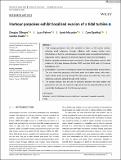Files in this item
Harbour porpoises exhibit localized evasion of a tidal turbine
Item metadata
| dc.contributor.author | Gillespie, Douglas Michael | |
| dc.contributor.author | Palmer, Laura Eve | |
| dc.contributor.author | MacAulay, Jamie Donald John | |
| dc.contributor.author | Sparling, Carol Elizabeth | |
| dc.contributor.author | Hastie, Gordon Drummond | |
| dc.date.accessioned | 2021-07-08T11:30:08Z | |
| dc.date.available | 2021-07-08T11:30:08Z | |
| dc.date.issued | 2021-09 | |
| dc.identifier | 274449480 | |
| dc.identifier | 8ee72361-9fea-4f6d-835d-64e610dcc89c | |
| dc.identifier | 000670532900001 | |
| dc.identifier | 85109372224 | |
| dc.identifier.citation | Gillespie , D M , Palmer , L E , MacAulay , J D J , Sparling , C E & Hastie , G D 2021 , ' Harbour porpoises exhibit localized evasion of a tidal turbine ' , Aquatic Conservation: Marine and Freshwater Ecosystems , vol. 31 , no. 9 , pp. 2459-2468 . https://doi.org/10.1002/aqc.3660 | en |
| dc.identifier.issn | 1052-7613 | |
| dc.identifier.other | ORCID: /0000-0001-7658-5111/work/96817227 | |
| dc.identifier.other | ORCID: /0000-0001-9628-157X/work/96817351 | |
| dc.identifier.other | ORCID: /0000-0002-9773-2755/work/96817468 | |
| dc.identifier.uri | https://hdl.handle.net/10023/23494 | |
| dc.description | Funding: Scottish Government (Grant Number(s): Marine Mammal Scientific Support Program MMSS/002/); Natural Environment Research Council (Grant Number(s): NE/R014639/1, NE/R015007/1). | en |
| dc.description.abstract | 1. Tidal energy generators have the potential to injure or kill marine animals, including small cetaceans, through collisions with moving turbine parts. Information on the fine scale behaviour of animals close to operational turbines is required to inform regulators of the likely impact of these new technologies. 2. Harbour porpoise movements were monitored in three dimensions around a tidal turbine for 451 days between October 2017 and April 2019 with a 12-channel hydrophone array. 3. Echolocation clicks from 344 porpoise events were localized close to the turbine. The data show that porpoises effectively avoid the turbine rotors, with only a single animal clearly passing through the rotor swept area while the rotors were stationary, and none passing through while rotating. 4. The results indicate that the risk of collisions between the tidal turbine and porpoises is low; this has important implications for the potential effects and the sustainable development of the tidal energy industry. | |
| dc.format.extent | 10 | |
| dc.format.extent | 2519606 | |
| dc.language.iso | eng | |
| dc.relation.ispartof | Aquatic Conservation: Marine and Freshwater Ecosystems | en |
| dc.subject | Behaviour | en |
| dc.subject | Coastal | en |
| dc.subject | Distribution | en |
| dc.subject | Environmental impact assessment | en |
| dc.subject | Mammals | en |
| dc.subject | Renewable energy | en |
| dc.subject | QL Zoology | en |
| dc.subject | VM Naval architecture. Shipbuilding. Marine engineering | en |
| dc.subject | DAS | en |
| dc.subject | SDG 7 - Affordable and Clean Energy | en |
| dc.subject | SDG 14 - Life Below Water | en |
| dc.subject.lcc | QL | en |
| dc.subject.lcc | VM | en |
| dc.title | Harbour porpoises exhibit localized evasion of a tidal turbine | en |
| dc.type | Journal article | en |
| dc.contributor.sponsor | NERC | en |
| dc.contributor.sponsor | NERC | en |
| dc.contributor.institution | University of St Andrews. School of Biology | en |
| dc.contributor.institution | University of St Andrews. Sea Mammal Research Unit | en |
| dc.contributor.institution | University of St Andrews. Scottish Oceans Institute | en |
| dc.contributor.institution | University of St Andrews. Marine Alliance for Science & Technology Scotland | en |
| dc.contributor.institution | University of St Andrews. Bioacoustics group | en |
| dc.contributor.institution | University of St Andrews. Sound Tags Group | en |
| dc.identifier.doi | 10.1002/aqc.3660 | |
| dc.description.status | Peer reviewed | en |
| dc.identifier.grantnumber | NE/R014639/1 | en |
| dc.identifier.grantnumber | NE/R015007/1 | en |
This item appears in the following Collection(s)
Items in the St Andrews Research Repository are protected by copyright, with all rights reserved, unless otherwise indicated.

